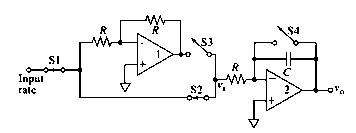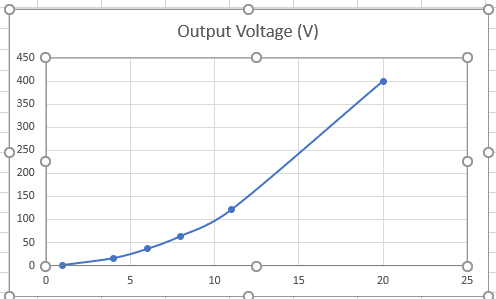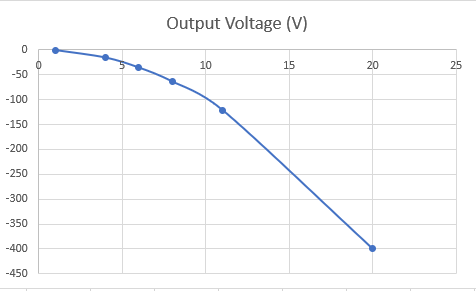
(a)
Interpretation:
The function of the operational amplifier 1 should be determined.
Concept introduction:
The operational amplifier is a high gain device and it amplifies the voltage. Generally, a voltage amplifier has a single output and differential input. So, basically, an operational amplifier produces an output much higher than the input voltage. The output voltage could be thousands of times higher than the input voltage.
Here, the given electronic circuit is as below:

Explanation of Solution
Given information:

The operational amplifier is a high gain device and it amplifies the voltage. Generally, a voltage amplifier has a single output and differential input. So basically, an operational amplifier produces an output much higher than the input voltage. The output voltage could be thousands of times higher than the input voltage.
Here the given electronic circuit is as below:

It can be seen that the operational amplifier 1 here performing the function of inverting voltage amplifier.
(b)
Interpretation:
The function of the operational amplifier 2 should be determined.
Concept introduction:
The operational amplifier is a high gain device and it amplifies the voltage. Generally, a voltage amplifier has a single output and differential input. So, basically, an operational amplifier produces an output much higher than the input voltage. The output voltage could be thousands of times higher than the input voltage.
Here the given electronic circuit is as below

Explanation of Solution
The operational amplifier is a high gain device and it amplifies the voltage. Generally, a voltage amplifier has a single output and differential input. So basically, an operational amplifier produces an output much higher than the input voltage. The output voltage could be thousands of times higher than the input voltage.
Here the given electronic circuit is as below:

It can be seen that the operational amplifier 2 here performing the function of integrating circuit and hence the integration.
(c)
Interpretation:
The output voltage during the interval
Concept introduction:
The operational amplifier is a high gain device and it amplifies the voltage. Generally, a voltage amplifier has a single output and differential input. So, basically, an operational amplifier produces an output much higher than the input voltage. The output voltage could be thousands of times higher than the input voltage.
Here the given electronic circuit is as below

Explanation of Solution
The operational amplifier is a high gain device and it amplifies the voltage. Generally, a voltage amplifier has a single output and differential input. So basically, an operational amplifier produces an output much higher than the input voltage. The output voltage could be thousands of times higher than the input voltage.
Here the given electronic circuit is as below:

Here the input voltage
Where
As per the problem switches
Here, the output signal can be given by the formula as below
Now assume
Substitute the values in the above equation and simplify, the result obtained is
The integrating voltage at different time intervals is given as:
| Time(s) | Output Voltage (V) |
| 1 | 1 |
| 4 | 16 |
| 6 | 36 |
| 8 | 64 |
| 11 | 121 |
| 20 | 40 |
The plot can be obtained as shown below:

(d)
Interpretation:
The output voltage during the second interval
Concept introduction:
The operational amplifier is a high gain device and it amplifies the voltage. Generally, a voltage amplifier has a single output and differential input. So, basically, an operational amplifier produces an output much higher than the input voltage. The output voltage could be thousands of times higher than the input voltage.
Here the given electronic circuit is as below

Explanation of Solution
The operational amplifier is a high gain device and it amplifies the voltage. Generally, a voltage amplifier has a single output and differential input. So basically, an operational amplifier produces an output much higher than the input voltage. The output voltage could be thousands of times higher than the input voltage.
Here the given electronic circuit is as below

Here the input voltage
Where
As per the problem switches
Here the output signal can be given by the formula as below
Where
Therefore, it can be said that
The output of the second operational amplifier which is actually the final output can be given by the equation as below:
Where
Now assume
Substitute the values in the above equation and simplify, the result obtained is
The integrating voltage at different time intervals is given as:
| Time(s) | Output Voltage (V) |
| 1 | -1 |
| 4 | -16 |
| 6 | -36 |
| 8 | -64 |
| 11 | -121 |
| 20 | -40 |
The plot can be obtained as shown below:

(e)
Interpretation:
The output voltage
Concept introduction:
The operational amplifier is a high gain device and it amplifies the voltage. Generally, a voltage amplifier has a single output and differential input. So, basically, an operational amplifier produces an output much higher than the input voltage. The output voltage could be thousands of times higher than the input voltage.
Here the given electronic circuit is as below

Explanation of Solution
The operational amplifier is a high gain device and it amplifies the voltage. Generally, a voltage amplifier has a single output and differential input. So basically, an operational amplifier produces an output much higher than the input voltage. The output voltage could be thousands of times higher than the input voltage.
Here the given electronic circuit is as below

Since there is no current so capacitor will discharge. And circuit will act as differentiator.
Further, it can be re-written as
The output can be given as
(f)
Interpretation:
The advantages and disadvantages of the given circuit over the normal amplifier should be described.
Concept introduction:
The operational amplifier is a high gain device and it amplifies the voltage. Generally, a voltage amplifier has a single output and differential input. So, basically, an operational amplifier produces an output much higher than the input voltage. The output voltage could be thousands of times higher than the input voltage.
Here the given electronic circuit is as below

Explanation of Solution
The operational amplifier is a high gain device and it amplifies the voltage. Generally, a voltage amplifier has a single output and differential input. So basically, an operational amplifier produces an output much higher than the input voltage. The output voltage could be thousands of times higher than the input voltage.
Here the given electronic circuit is as below

Since there is no current so capacitor will discharge. And circuit will act as differentiator.
In general, the normal operational amplifier circuit can be used as a differentiator circuit only. But the given integrating circuit can be used as differentiator as well as integrator. Just one disadvantage is that the given circuit has higher noise level as compared to the normal circuit.
(g)
Interpretation:
The scenario if the input signal gets changes with the slope during the measurement cycle should be determined.
Concept introduction:
The operational amplifier is a high gain device and it amplifies the voltage. Generally, a voltage amplifier has a single output and differential input. So, basically, an operational amplifier produces an output much higher than the input voltage. The output voltage could be thousands of times higher than the input voltage.
Here the given electronic circuit is as below

Explanation of Solution
The operational amplifier is a high gain device and it amplifies the voltage. Generally, a voltage amplifier has a single output and differential input. So basically, an operational amplifier produces an output much higher than the input voltage. The output voltage could be thousands of times higher than the input voltage.
Here the given electronic circuit is as below

Since there is no current so capacitor will discharge. And circuit will act as differentiator.
The output of the second operational amplifier which is actually the final output can be given by the equation as below:
Where
Now assume
Substitute the values in the above equation and simplify, the result obtained is
Further it can be written that
(h)
Interpretation:
The result obtained if the two-time intervals are separated by a time delay
Concept introduction:
The operational amplifier is a high gain device and it amplifies the voltage. Generally, a voltage amplifier has a single output and differential input. So, basically, an operational amplifier produces an output much higher than the input voltage. The output voltage could be thousands of times higher than the input voltage.
Here the given electronic circuit is as below

Explanation of Solution
The operational amplifier is a high gain device and it amplifies the voltage. Generally, a voltage amplifier has a single output and differential input. So basically, an operational amplifier produces an output much higher than the input voltage. The output voltage could be thousands of times higher than the input voltage.
Here the given electronic circuit is as below

For the given circuit the during the first time interval
Now if the two-time intervals are separated by a time delay
(i)
Interpretation:
The result if the two-time intervals were of different duration should be determined.
Concept introduction:
The operational amplifier is a high gain device and it amplifies the voltage. Generally, a voltage amplifier has a single output and differential input. So, basically, an operational amplifier produces an output much higher than the input voltage. The output voltage could be thousands of times higher than the input voltage.
Here the given electronic circuit is as below

Explanation of Solution
The operational amplifier is a high gain device and it amplifies the voltage. Generally, a voltage amplifier has a single output and differential input. So basically, an operational amplifier produces an output much higher than the input voltage. The output voltage could be thousands of times higher than the input voltage.
Here the given electronic circuit is as below

As its known that, if the two-time intervals are same then the plot of the output voltage is same in magnitude and opposite in sign for both the interval. But if the two-time intervals are of different duration then the magnitude of output signal will be different for both the time periods.
(j)
Interpretation:
The reason should be discussed for why the time interval is desirable to be as large as possible in measuring enzyme
Concept introduction:
The operational amplifier is a high gain device and it amplifies the voltage. Generally, a voltage amplifier has a single output and differential input. So, basically, an operational amplifier produces an output much higher than the input voltage. The output voltage could be thousands of times higher than the input voltage.
Here the given electronic circuit is as below:

Explanation of Solution
The operational amplifier is a high gain device and it amplifies the voltage. Generally, a voltage amplifier has a single output and differential input. So basically, an operational amplifier produces an output much higher than the input voltage. The output voltage could be thousands of times higher than the input voltage.
Here the given electronic circuit is as below

Since there is no current so capacitor will discharge. And circuit will act as differentiator.
The output of the second operational amplifier which is actually the final output can be given by the equation as below:
Where
Now, assume
Substitute the values in the above equation and simplify, the result obtained is
If the time gets larger then the output voltage also gets larger.
Enzyme kinematics are generally time-consuming process. So, its desirable to have larger time.
Want to see more full solutions like this?
Chapter 3 Solutions
INSTRUMENTAL ANALYSIS-ACCESS >CUSTOM<
- A student proposes the transformation below in one step of an organic synthesis. There may be one or more reactants missing from the left-hand side, but there are no products missing from the right-hand side. There may also be catalysts, small inorganic reagents, and other important reaction conditions missing from the arrow. • Is the student's transformation possible? If not, check the box under the drawing area. • If the student's transformation is possible, then complete the reaction by adding any missing reactants to the left-hand side, and adding required catalysts, inorganic reagents, or other important reaction conditions above and below the arrow. • You do not need to balance the reaction, but be sure every important organic reactant or product is shown. + T G OH де OH This transformation can't be done in one step.arrow_forwardMacmillan Leaming Draw the major organic product of the reaction. 1. CH3CH2MgBr 2. H+ - G Select Draw Templates More H о QQarrow_forwardDraw the condensed structure of 3-hydroxy-2-butanone. Click anywhere to draw the first atom of your structure.arrow_forward
- Give the expected major product of reaction of 2,2-dimethylcyclopropane with each of the following reagents. 2. Reaction with dilute H₂SO, in methanol. Select Draw Templates More CHC Erase QQQ c. Reaction with dilute aqueous HBr. Select Drew Templates More Era c QQQ b. Reaction with NaOCH, in methanol. Select Draw Templates More d. Reaction with concentrated HBr. Select Draw Templates More En a QQQ e. Reaction with CH, Mg1, then H*, H₂O 1. Reaction with CH,Li, then H', H₂Oarrow_forwardWrite the systematic name of each organic molecule: structure O OH OH name X ☐arrow_forwardMacmillan Learning One of the molecules shown can be made using the Williamson ether synthesis. Identify the ether and draw the starting materials. А со C Strategy: Review the reagents, mechanism and steps of the Williamson ether synthesis. Determine which of the molecules can be made using the steps. Then analyze the two possible disconnection strategies and deduce the starting materials. Identify the superior route. Step 6: Put it all together. Complete the two-step synthesis by selecting the reagents and starting materials. C 1. 2. Answer Bank NaH NaOH NaOCH, снен, сен, он Сиси, Сне (СН), СОН (Сн, Свarrow_forward
- Write the systematic name of each organic molecule: structure CH3 O CH3-CH-CH-C-CH3 OH HV. CH3-C-CH-CH2-CH3 OH CH3 O HO—CH, CH–CH—C CH3 OH 오-오 name X G ☐arrow_forwardHI Organic Functional Groups Predicting the reactants or products of esterification What is the missing reactant in this organic reaction? HO OH H +回 + H₂O 60013 Naomi V Specifically, in the drawing area below draw the skeletal ("line") structure of R. If there is more than one reasonable answer, you can draw any one of them. If there is no reasonable answer, check the No answer box under the drawing area. No answer Click and drag to start drawing a structure. Explanation Check 1 2 #3 $ 4 2025 % ala5 'a :☐ G & 67 8 Ar K enter Accessible 9 Q W E R TY U 1 tab , S H J Karrow_forwardPlease help me with number 5 using my data and graph. I think I might have number 3 and 4 but if possible please check me. Thanks in advance!arrow_forward
- dict the major products of this organic reaction. C Explanation Check 90 + 1.0₂ 3 2. (CH3)2S Click and drag f drawing a stru © 2025 McGraw Hill LLC. All Rights Reserved. • 22 4 5 7 8 Y W E R S F H Bilarrow_forwardcan someone draw out the reaction mechanism for this reaction showing all the curly arrows and 2. Draw the GPNA molecule and identify the phenylalanine portion. 3. Draw L-phenylalanine with the correct stereochemistryarrow_forwardWhat is the reaction mechanism for this?arrow_forward
 Physical ChemistryChemistryISBN:9781133958437Author:Ball, David W. (david Warren), BAER, TomasPublisher:Wadsworth Cengage Learning,
Physical ChemistryChemistryISBN:9781133958437Author:Ball, David W. (david Warren), BAER, TomasPublisher:Wadsworth Cengage Learning, Chemistry for Engineering StudentsChemistryISBN:9781285199023Author:Lawrence S. Brown, Tom HolmePublisher:Cengage Learning
Chemistry for Engineering StudentsChemistryISBN:9781285199023Author:Lawrence S. Brown, Tom HolmePublisher:Cengage Learning Principles of Instrumental AnalysisChemistryISBN:9781305577213Author:Douglas A. Skoog, F. James Holler, Stanley R. CrouchPublisher:Cengage Learning
Principles of Instrumental AnalysisChemistryISBN:9781305577213Author:Douglas A. Skoog, F. James Holler, Stanley R. CrouchPublisher:Cengage Learning Principles of Modern ChemistryChemistryISBN:9781305079113Author:David W. Oxtoby, H. Pat Gillis, Laurie J. ButlerPublisher:Cengage Learning
Principles of Modern ChemistryChemistryISBN:9781305079113Author:David W. Oxtoby, H. Pat Gillis, Laurie J. ButlerPublisher:Cengage Learning




